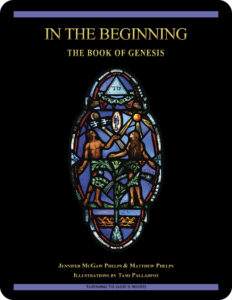 In the Beginning:
In the Beginning:
The Book of Genesis
Lesson 8 The Call of Abram
the book of Genesis 12:1—14:24
Revised Standard Version Catholic Edition (RSVCE)*
New American Bible Revised Edition (NABRE)*
Catechism of the Catholic Church
ex libris (in our library)
Lumen Fidei (Light of Faith)
glossary for the book of Genesis
cross references in the book of Genesis
next lesson: Abram Questions the Lord GOD
This material coordinates with Lesson 8 on pages 44–50 in the study book In the Beginning: The Book of Genesis.
“And God saw everything that he had made, and behold, it was very good. And there was evening and there was morning, a sixth day. Thus the heavens and the earth were finished, and all the host of them. And on the seventh day God finished his work which he had done, and he rested on the seventh day from all his work which he had done.”—the book of Genesis 1:31—2:2
welcome to our in-depth study of the book of Genesis
We invite interested groups and individuals to check out the sample first lesson from this 28-lesson  Turning to God’s Word Catholic Bible study.
Turning to God’s Word Catholic Bible study.  These online study pages link to free lesson videos, an online glossary, and a list of cross references in the biblical text. Other study aids include maps, charts, illustrations, additional commentary, and prayers based on the primary Scripture in each lesson. In the Beginning: The Book of Genesis has been granted an imprimatur and can be purchased from our website shop. If you have a Bible-related question or comment, click on one of the “ask us your question” or “what do you think” buttons on any online study page.
These online study pages link to free lesson videos, an online glossary, and a list of cross references in the biblical text. Other study aids include maps, charts, illustrations, additional commentary, and prayers based on the primary Scripture in each lesson. In the Beginning: The Book of Genesis has been granted an imprimatur and can be purchased from our website shop. If you have a Bible-related question or comment, click on one of the “ask us your question” or “what do you think” buttons on any online study page.
open with prayer
It’s always wise to begin any Bible study with prayer, whether reading the Scriptures alone or meeting with others in a discussion study group. You can pray using your own words or use one of the opening prayers on our website. We especially like the following:
Lord Jesus, you promised to send your Holy Spirit to teach us all things.
As we read and study your word today,
allow it to touch our hearts and change our lives. Amen.
let’s review—the book of Genesis 9:18—11:32
In Lesson 7 Canaan: A Slave of Slaves, God reestablishes his relationship with what’s left of humanity after the Great Flood. The LORD does this through a covenant with Noah. The ninth chapter in the book of Genesis records an unexpected first in the Bible when it describes Noah getting drunk. The disrespectful reaction of Noah’s son Ham leads to big problems. It’s a shock to present-day readers that Noah chooses to curse his grandson Canaan for Ham’s behavior and not Ham himself. The prophecy that Noah issues foretells that Canaan will serve as a slave to Shem, and this will play out in the reactions between the descendants of Canaan and those of Shem. At this stage in salvation history, descendants of Shem are called Hebrews. Later, they will be called Israelites after the patriarch Jacob, who was renamed Israel by God. Still later, after the Babylonian Exile, practitioners of the religion of Judaism will be called Jews. Descendants of Jacob’s son Judah properly are called Judahites.
map notes—God says go, so Abram goes
The map with this lesson is one of the more complex in this study. It marks the routes of 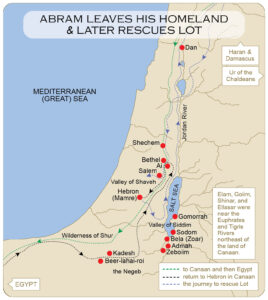 Abram’s initial journey into the land of Canaan and his trip to Egypt, as well as the route that he took north to rescue his nephew Lot. The obvious thing that can be learned from the map is that Abram gets around quite a bit for a man of 75. The four kings who captured Lot were from the same region that Abram and Lot left when they journeyed to the land of Canaan. One of the most remarkable traits of Abram is his willingness to leave his homeland just because God asked. Elam, Goiim, Shinar, and Ellasar were located in the area of the Euphrates and Tigris Rivers, northeast of the land of Canaan and beyond the scope of this map. Click on the map (right) to enlarge it. The original map is on page 47 in the study book In the Beginning: The Book of Genesis.
Abram’s initial journey into the land of Canaan and his trip to Egypt, as well as the route that he took north to rescue his nephew Lot. The obvious thing that can be learned from the map is that Abram gets around quite a bit for a man of 75. The four kings who captured Lot were from the same region that Abram and Lot left when they journeyed to the land of Canaan. One of the most remarkable traits of Abram is his willingness to leave his homeland just because God asked. Elam, Goiim, Shinar, and Ellasar were located in the area of the Euphrates and Tigris Rivers, northeast of the land of Canaan and beyond the scope of this map. Click on the map (right) to enlarge it. The original map is on page 47 in the study book In the Beginning: The Book of Genesis.
 God makes a big promise to Abram (55:58)
God makes a big promise to Abram (55:58)
The first recorded word from God to Abram is “Go,” and even though Abram is 75  years old, he complies with the LORD’s request—possibly because it suggests an attractive if somewhat nebulous promise of future children, land, and blessing. Abram’s wife Sarai is barren, and the specific Promised Land currently is occupied by the descendants of Noah’s grandson Canaan—two things that point to Abram’s faith in the LORD’s ability to overcome such obstacles. The twelfth chapter in the book of Genesis includes the story of Abram’s rescue of his nephew Lot. Turning to God’s Word author Matthew
years old, he complies with the LORD’s request—possibly because it suggests an attractive if somewhat nebulous promise of future children, land, and blessing. Abram’s wife Sarai is barren, and the specific Promised Land currently is occupied by the descendants of Noah’s grandson Canaan—two things that point to Abram’s faith in the LORD’s ability to overcome such obstacles. The twelfth chapter in the book of Genesis includes the story of Abram’s rescue of his nephew Lot. Turning to God’s Word author Matthew  Phelps discusses the significant meeting between Abram and Melchizedek, the king of Salem and the first priest of God Most High named in the Old Testament.
Phelps discusses the significant meeting between Abram and Melchizedek, the king of Salem and the first priest of God Most High named in the Old Testament.
The Scripture ranges for the videos that accompany this Catholic Bible study from Turning to God’s Word match the Scripture ranges for the sets of questions in In the Beginning: The Book of Genesis. You can follow along with the video overview as Turning to God’s Word author Matthew Phelps discusses Lesson 8, “The Call of Abram,” on pages 44–50 in the study book.
WHAT DO YOU THINK a call from God is like?
It’s impossible to tell from the biblical text exactly how it was that God communicated with Abram, though it’s clear that Abram understood what God was asking of him.
? What do you think God’s voice sounded like to Abram?
 ? Consider whether God also might have been speaking to others.
? Consider whether God also might have been speaking to others.
? How do you suppose that Abram was able to hear God’s voice?
? Consider whether you think that God speaks to present-day men and women in the same way that he spoke to Abram. What evidence supports your viewpoint?
? What biblical evidence argues against it?
? Have you ever heard God speaking to you?
? What dangers are inherent in believing that you’ve heard the voice of God telling you to do something?
? What dangers are inherent in ignoring the voice of God telling you to do something?
? How can you discern mere thoughts in your mind from the voice of God?
? What assistance does the Church provide in helping with such discernment?
ex libris—two books about spiritual direction
Two of the best books we’ve recently come across that discuss the practical ins and outs of 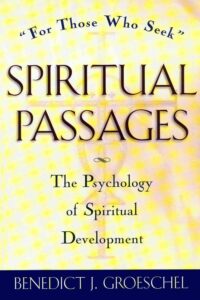
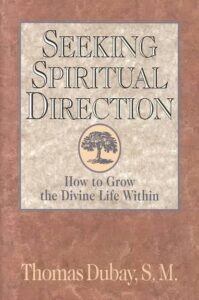 discernment are Spiritual Passages by Benedict Groeschel, C.F.R., and Seeking Spiritual Direction by Thomas Dubay, S.M.
discernment are Spiritual Passages by Benedict Groeschel, C.F.R., and Seeking Spiritual Direction by Thomas Dubay, S.M.  Both authors have written other excellent books as well, but people interested in learning more about spiritual direction may find these two titles particularly insightful. At ex libris—main bookshelf, you can read excerpts from both of these books by Catholic priests, and you also can learn more about other works related to Catholic Bible study.
Both authors have written other excellent books as well, but people interested in learning more about spiritual direction may find these two titles particularly insightful. At ex libris—main bookshelf, you can read excerpts from both of these books by Catholic priests, and you also can learn more about other works related to Catholic Bible study.
who is Melchizedek in the Old Testament?
Perhaps one of the most mysterious figures in Scripture, Melchizedek shows up only in a few short verses in the Old Testament book of Genesis 14:17–20 and in Psalm 110:4. Ordinarily, this would signal to readers that Melchizedek is a figure of very little importance in salvation history. His name doesn’t appear in any of the many lineages in Scripture, and there’s no information about his birth or his death. But because the author of the New Testament Letter to the Hebrews devotes a large portion of his writing to explaining how Melchizedek prefigures Jesus, it’s obvious that Melchizedek is not a minor figure in the story of our faith.
The limited information in Scripture about Melchizedek has led to a number of speculative theories about him. It’s important Catholics recognize that these speculations don’t represent Church teaching. While it’s true that Melchizedek is an important figure, there’s very little information about him supplied in the Bible. Any of the speculative theories about him are just that—speculation that isn’t endorsed by the Church. In the present-day, a number of people allow themselves to be sucked in. They’re more interested in learning “secrets” than in establishing a relationship with God based on truth. This emphasis on learning some secret knowledge is the basis of the heresy of gnosticism.
how to approach mysteries in Scripture
This probably is a good time to reiterate Church stipulations for interpreting Scripture. It also might be a good time to read or reread Dei Verbum, the dogmatic constitution on divine revelation written by Pope Paul VI in 1968. Catholics are encouraged to read and think about Scripture—as long as our interpretations don’t fly in the face of anything else in Scripture or contradict Church teaching. This is a tall order, requiring humility on our part and a willingness to admit there certainly are things in Scripture and Church teaching that we don’t understand and in many cases haven’t even been exposed to. It’s for this reason that all Turning to God’s Word study materials are submitted to the Church for an imprimatur prior to publication. It’s extremely easy for any of us to overlook what we don’t know.
It’s also easy to get bogged down by an academic approach to Bible study. The danger of this is that by focusing on our search for answers, we run the risk of missing the gist of what God is trying to say to us individually. There’s nothing wrong with seeking to understand Scripture, but occasionally we need to  ask ourselves what is motivating our study and how much of our lives we’re willing to open to God. When God talks to us, he isn’t interested in hearing how we think he should be running things or what kind of problems we foresee associated with doing what he’s asking of us at the moment. He’s not asking for our opinions, he’s asking for our obedience. We can be learning all kinds of things about Scripture, but if we’re ignoring God’s messages (routinely cheating our employers or others or mistreating our family members and other acquaintances, for example) we probably need to try a different, more spiritual approach—one modeled by Abraham. It’s not for nothing that he’s known as the father of our faith. In the video overview that accompanies this lesson, Turning to God’s Word author Matthew Phelps discusses what makes Abraham (Abram at this point in the book of Genesis) such a terrific role model. The other great role model we can turn to for help if how to approach our faith is the Blessed Virgin Mary.
ask ourselves what is motivating our study and how much of our lives we’re willing to open to God. When God talks to us, he isn’t interested in hearing how we think he should be running things or what kind of problems we foresee associated with doing what he’s asking of us at the moment. He’s not asking for our opinions, he’s asking for our obedience. We can be learning all kinds of things about Scripture, but if we’re ignoring God’s messages (routinely cheating our employers or others or mistreating our family members and other acquaintances, for example) we probably need to try a different, more spiritual approach—one modeled by Abraham. It’s not for nothing that he’s known as the father of our faith. In the video overview that accompanies this lesson, Turning to God’s Word author Matthew Phelps discusses what makes Abraham (Abram at this point in the book of Genesis) such a terrific role model. The other great role model we can turn to for help if how to approach our faith is the Blessed Virgin Mary.
 what the Church teaches about Melchizedek
what the Church teaches about Melchizedek
The best place to learn what the Church teaches about any given Christian topic is the Catechism of the Catholic Church, which is a marvelous gift to present-day Catholics. A look at the Catechism reinforces the importance of Melchizedek by devoting several paragraphs to discussing how it is that Melchizedek is seen as a type of Jesus. (Any number of other figures who receive only minimal mention in the Old or New Testaments aren’t mentioned at all in the Catechism, a sure indicator that while these people may be necessary to the narration of the stories included in Scripture, they play only minor roles in salvation history.) Paragraphs 58, 1333, 1544 all mention Melchizedek by name. It’s significant that the Church distinguishes between the type of priesthood practiced by Melchizedek and the type of priesthood practiced by Aaron and his descendants.
Two things are at the heart of these differences, and they aren’t always readily apparent to casual readers. The first is the eternal nature of Melchizedek, and therefore of the order of his priesthood. The  second is what Melchizedek does as a priest opposed to what Aaron and his descendants are tasked with doing. It’s much easier to locate what these are in the book of Genesis 14:17–20 than it is to find commentary that addresses these differences, especially the latter one. Again, Turning to God’s Word author Matthew Phelps discusses these on the video overview for this lesson.
second is what Melchizedek does as a priest opposed to what Aaron and his descendants are tasked with doing. It’s much easier to locate what these are in the book of Genesis 14:17–20 than it is to find commentary that addresses these differences, especially the latter one. Again, Turning to God’s Word author Matthew Phelps discusses these on the video overview for this lesson.
 sojourn—you could look it up in our archives
sojourn—you could look it up in our archives
Abram sojourns in Egypt during a famine. Although the word sojourn looks as though it might be related to making a journey, it refers to a temporary stay. To learn more, read Lost in Translation, an online column in which Turning to God’s Word author Matthew Phelps helps readers connect with ideas expressed in the original languages of the Scriptures. New Lost in Translation entries are posted on Mondays, and past entries are archived on our website. Contact us if you’d like to receive Lost in Translation by email every week.
read this item only if you love language
The Revised Standard Version Second Catholic Edition (RSV2CE) translation of the Bible reprinted in our studies as well as the Revised Standard Version Catholic Edition (RSVCE) that we link to online somewhat surprisingly retain a few uses of out-of-date English language. One of these instances shows up in the book of Genesis 12:8, which recounts Abram’s initial travels in the land of Canaan: “Thence he removed to the mountain on the east of Bethel … .” Because of its spelling, present-day readers often assume the word “thence” is a substitute for the word “then.” “Hence,” “thence,” and “whence” are old-fashioned words that have to do with moving from a place. (The idea of “from” is included in these words, so it would be redundant to say or write “from thence.”) “Hence” means “from here,” “thence” means “from there,” and “whence” asks the question “where from?” An alternate translation of the phrase in the book of Genesis 12:8 that would be more understandable to present-day readers would be: “From there he went on to the mountain on the east of Bethel … .” In a similar fashion, “hither,” “thither,” and “whither” are words that have to do with moving to a place, and the idea of “to” is included in these words. “Hither” means “to here,” “thither” means “to there,” and “whither” means “to somewhere unknown.” We expect most English translations eventually will change to the more commonly used vernacular.
the popes inspire us—called to be faithful
In the following excerpt from Lumen Fidei (Light of Faith), Pope Francis discusses the mysterious relationships between faith and hope, listening and seeing, and how these are  tied to remembering God’s promises. You can find links to other magisterial documents referred to in Turning to God’s Word Catholic Bible studies at ex libris—magisterial documents.
tied to remembering God’s promises. You can find links to other magisterial documents referred to in Turning to God’s Word Catholic Bible studies at ex libris—magisterial documents.
“Faith opens the way before us and accompanies our steps through time. Hence, if we want to understand what faith is, we need to follow the route it has taken, the path trodden by believers, as witnessed first in the Old Testament. Here a unique place belongs to Abraham [Abram], our father in faith. Something disturbing takes place in his life: God speaks to him; he reveals himself as a God who speaks and calls his name. Faith is linked to hearing. Abraham doesn’t see God, but he hears God’s voice. Faith thus takes on a personal aspect. God isn’t the god of a particular place, or a deity linked to specific sacred time, but the God of a person … .
“The word spoken to Abraham contains both a call and a promise. First, it’s a call to leave his own land, a summons to a new life, the beginning of an exodus that points him toward an unforeseen future. The sight that faith would give to Abraham would always be linked to the need to take this step forward: Faith “sees” to the extent that it journeys, to the extent that it chooses to enter into the horizons opened up by God’s word. This word also contains a promise: Your descendants will be great in number, you will be the father of a great nation (the book of Genesis 13:16; 15:5; and 22:17). As a response to a word that preceded it, Abraham’s faith always would be an act of remembrance. Yet this remembrance isn’t fixed on past events but, as the memory of a promise, it becomes capable of opening up the future, shedding light on the path to be taken. We see how faith, as remembrance of the future, memoria futuri, is thus closely bound up with hope.
“Abraham is asked to entrust himself to this word. Faith understands that something so apparently ephemeral and fleeting as a word, when spoken by the God who is fidelity, becomes absolutely certain and unshakable, guaranteeing the continuity of our journey through history. Faith accepts this word as a solid rock upon which we can build, a straight highway on which we can travel.”
two videos about salvation history (1:34:09 & 1:31:35)
The biblical development of the priesthood was the theme of the 2016 Turning to God’s Word Bible study retreat at Conception Abbey. You can watch the following videos from Turning to God’s Word author Matthew Phelps‘ conference talks tracing the Catholic priesthood from Melchizedek to Jesus Christ. For talks from other previous retreats, check out our video page.
the best Catholic commentary about Scripture
 To find out more about how Church teaching is supported by Scripture passages in In the Beginning: The Book of Genesis, check out the Index of Citations in the Catechism of the Catholic Church. Links to the primary Scripture passages in the lesson (Revised Standard Version Catholic Edition [RSVCE*]) and relevant paragraphs in the Catechism are provided here. Not every passage in the biblical text for this Catholic study is referenced in a Catechism paragraph, however.
To find out more about how Church teaching is supported by Scripture passages in In the Beginning: The Book of Genesis, check out the Index of Citations in the Catechism of the Catholic Church. Links to the primary Scripture passages in the lesson (Revised Standard Version Catholic Edition [RSVCE*]) and relevant paragraphs in the Catechism are provided here. Not every passage in the biblical text for this Catholic study is referenced in a Catechism paragraph, however.
the book of Genesis 12:1—paragraph 59
the book of Genesis 12:1–4—paragraph 145
the book of Genesis 12:2—paragraphs 762, 1669
the book of Genesis 12:3—paragraphs 59, 706, 2676
the book of Genesis 12:4—paragraph 2570
the book of Genesis 13:8—paragraph 500
the book of Genesis 14:16—paragraph 500
the book of Genesis 14:18—paragraphs 58, 1333, 1544
ways our glossary might prove helpful
In addition to providing extra information about geographical locations, our glossary also points out  persons or places mentioned in the biblical text under more than one name or more than one spelling. If you can remember a name but aren’t sure in which lesson it shows up, you can find it in the glossary, which lists every proper noun that appears in the biblical text for every lesson in In the Beginning: The Book of Genesis.
persons or places mentioned in the biblical text under more than one name or more than one spelling. If you can remember a name but aren’t sure in which lesson it shows up, you can find it in the glossary, which lists every proper noun that appears in the biblical text for every lesson in In the Beginning: The Book of Genesis.
to learn more, read more Scripture
If you’re having difficulty with a particular passage of Scripture, it can be helpful to read the relevant  cross references—but looking these up can take time. To make that easier, we’ve compiled the cross references from the Revised Standard Version Second Catholic Edition (RSV2CE)—the translation that we reprint in our study books. A link to that list can be found at the top of every online study page; the list features links to cross references in the primary biblical text in the study book In the Beginning: The Book of Genesis.
cross references—but looking these up can take time. To make that easier, we’ve compiled the cross references from the Revised Standard Version Second Catholic Edition (RSV2CE)—the translation that we reprint in our study books. A link to that list can be found at the top of every online study page; the list features links to cross references in the primary biblical text in the study book In the Beginning: The Book of Genesis.
don’t forget about our indexes & extra online material

 If you’re trying to locate information about a specific Scripture passage, you can look it up in the index at the back of the study book or sample lesson. If you want to find a particular commentary, you can look up its title in the topics index. To learn more about another book of the Bible for which there’s a Turning to God’s Word study, visit the online study directories to read the commentaries and watch any accompanying videos. Finally, if you have a question or would like to make a comment about any of our studies, you can use one of the “ask us your question” or “what do you think” buttons to email our authors.
If you’re trying to locate information about a specific Scripture passage, you can look it up in the index at the back of the study book or sample lesson. If you want to find a particular commentary, you can look up its title in the topics index. To learn more about another book of the Bible for which there’s a Turning to God’s Word study, visit the online study directories to read the commentaries and watch any accompanying videos. Finally, if you have a question or would like to make a comment about any of our studies, you can use one of the “ask us your question” or “what do you think” buttons to email our authors.
ex libris—Church documents & books about religious topics
Link to magisterial documents referred to in our Bible studies at ex libris—magisterial documents.  This listing includes significant recent encyclicals as well as a number of historical Church documents. Recommended books related to Scripture study can be found at ex libris—main bookshelf.
This listing includes significant recent encyclicals as well as a number of historical Church documents. Recommended books related to Scripture study can be found at ex libris—main bookshelf.
wondering how to pronounce some of these words?
The following link is to a reading from the New International Version (NIV) Bible. To listen, open the link and click on the audio icon above the printed text. Although not taken from the translations used in our study materials, the NIV reading provides an audio guide to pronunciation of words in this lesson’s primary biblical text. A close online version of the translation of the Bible used in Catholic liturgy in the United States as well as an audio guide for daily Mass readings for the current month can be found on the website of the United States Conference of Catholic Bishops (USCCB).
the book of Genesis 12:1—14:24 (NIV)
 close with Bible-based prayer related to this lesson
close with Bible-based prayer related to this lesson
Many of our Catholic study groups like to conclude their discussions with a prayer based on the scriptural focus of their lesson, and some participants include Scripture-specific prayer in their individual study. If you’re uncomfortable composing your own Bible-based prayers, you can follow our four easy steps. If you prefer, you can use the following prayer based on this lesson’s text from the book of Genesis.
O God, you called Abram to leave his homeland.
Teach us to recognize your voice
and to respond without hesitation when you call us.
We ask this in the name of your Son, Jesus Christ,
whose every act reflected your love for humanity. Amen.
Lesson 9 Abram Questions the Lord GOD—the book of Genesis 15:1—16:16
Lesson 7 Canaan, a Slave of Slaves—the book of Genesis 9:18—11:32
you also may like our study of the book of Exodus
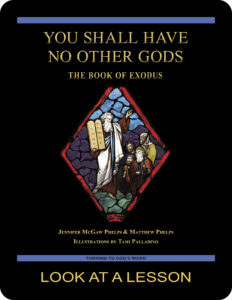 You Shall Have No Other Gods: The Book of Exodus, a 28-lesson Catholic Bible study with an imprimatur, provides an in-depth look at how significant events in biblical history that occurred thousands of years ago to descendants of Jacob remain relevant and even critical for present-day Christians to understand. The deliverance of the Hebrews from slavery in Egypt and the giving of Ten Commandments are examined along with the development of Moses’ relationship to God. Click on the book’s cover to view a sample lesson.
You Shall Have No Other Gods: The Book of Exodus, a 28-lesson Catholic Bible study with an imprimatur, provides an in-depth look at how significant events in biblical history that occurred thousands of years ago to descendants of Jacob remain relevant and even critical for present-day Christians to understand. The deliverance of the Hebrews from slavery in Egypt and the giving of Ten Commandments are examined along with the development of Moses’ relationship to God. Click on the book’s cover to view a sample lesson.
start a Turning to God’s Word Bible study
 Thank you for your interest in our study In the Beginning: The Book of Genesis.
Thank you for your interest in our study In the Beginning: The Book of Genesis.  Information about beginning a Turning to God’s Word Catholic Bible study can be found at start a Bible study. Tami, Matthew, and I are available to answer questions and offer support. Contact us if you’d like to start a Turning to God’s Word study or have your schedule listed with other TtGW study groups on our website. —Jennifer
Information about beginning a Turning to God’s Word Catholic Bible study can be found at start a Bible study. Tami, Matthew, and I are available to answer questions and offer support. Contact us if you’d like to start a Turning to God’s Word study or have your schedule listed with other TtGW study groups on our website. —Jennifer
*There are seven deuterocanonical books in the Old Testament—the Books of Tobit, Judith, Wisdom, Sirach, Baruch, and First and Second Maccabees, as well as some passages in the Books of Esther and Daniel. Protestants usually refer to these works as “apocryphal,” a word that means “outside the (Protestant) canon” because they’re excluded from most Protestant Bibles. The word “deuterocanonical” means “second canon”; Catholics use that word to refer to any section of the Catholic Old Testament for which there are no extant, or existing, Hebrew manuscripts. All of the deuterocanonical books appear in the Septuagint, the earliest remaining versions of which date to the 1st century B.C. This Greek translation of the Old Testament was in common use by Jews at the time of Jesus. Learn more by reading How Do Catholic & Protestant Bibles Differ?
Turning to God’s Word printed Bible studies use the 2006 Revised Standard Version Second Catholic Edition (RSV2CE) translation for all Scripture references except those to the Psalms, which are taken from The Abbey Psalms and Canticles, prepared by the Benedictine monks of Conception Abbey and published in 2020 by the United States Conference of Catholic Bishops (USCCB). All Scripture links for the online study pages for In the Beginning: The Book of Genesis are to the 1966 Revised Standard Version Catholic Edition (RSVCE) translation. The New International Version (NIV) audio recordings follow the same chapter and verse numbering as the RSV Catholic translations, but the NIV translation doesn’t include the deuterocanonical books and passages.
The 1966 RSVCE uses archaic pronouns and verb forms such as “thee,” “thou,” “didst” in the Psalms and in direct quotations attributed to God. The 2006 RSV2CE replaces these with more accessible English. The few significant translation changes in the RSV2CE include rendering almah as “virgin” in the Book of Isaiah 7:14 and restoring the term “begotten” in the Gospel According to John 3:16.
Numbering varies for some passages in this Bible study. Turning to God’s Word studies (print and digital) follow the numbering in the Revised Standard Version Catholic translations (RSV2CE and RSVCE). Discrepancies in the New American Bible Revised Edition (NABRE) are noted in the Index of Scripture Citations in the study book and the online sample.
 You can learn more about the Psalms by viewing a sample lesson from the Turning to God’s Word Catholic Bible study Sing a New Psalm: Communicating with God Through the Prayers of the Church—Volume I: Lauds & Vespers. The second part of that study, Sing a New Psalm: Communicating with God Through the Prayers of the Church—Volume II: Vigils, Day Prayer & Compline, is scheduled for publication in 2025. Some verse numbers may vary in different translations of the Psalms.
You can learn more about the Psalms by viewing a sample lesson from the Turning to God’s Word Catholic Bible study Sing a New Psalm: Communicating with God Through the Prayers of the Church—Volume I: Lauds & Vespers. The second part of that study, Sing a New Psalm: Communicating with God Through the Prayers of the Church—Volume II: Vigils, Day Prayer & Compline, is scheduled for publication in 2025. Some verse numbers may vary in different translations of the Psalms.
